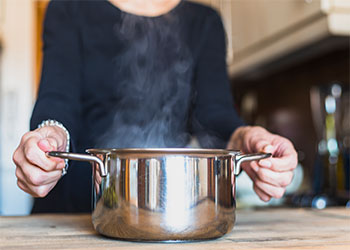Stainless steel pans are a staple in most kitchens due to their durability, even heat distribution, and non-reactive surface. They are excellent for cooking a wide range of dishes, from searing meats to sautéing vegetables. However, to maintain their pristine appearance and ensure they continue to perform at their best, regular cleaning is essential. Here are the best practices on how to clean stainless steel pans effectively.
Materials You’ll Need:
- Mild dish soap
- Non-abrasive sponge or soft cloth
- White vinegar or lemon juice
- Baking soda (optional)
- Microfiber cloth or soft towel
Step By Step Process:
- Cool Down Before Cleaning:
After cooking, allow the stainless steel pan to cool down slightly before attempting to clean it. Plunging a hot pan into cold water can cause warping and damage the pan’s integrity. Give it some time to cool off on the stovetop or a heat-resistant surface.
- Soak to Loosen Residue:
If you’re dealing with stubborn, stuck-on food residue, fill the pan with warm water and a few drops of dish soap. Let it soak for 15 to 30 minutes. The warm water and soap will help loosen the food particles, making them easier to remove.
- Avoid Abrasive Cleaners and Tools:
Stainless steel is a durable material, but it can still be scratched by abrasive cleaners or rough scrubbing tools. Avoid using steel wool, metal scouring pads, or harsh chemicals that may mar the pan’s surface. Opt for soft sponges, microfiber cloths, or gentle scrubbing brushes designed for stainless steel.
- Baking Soda Paste for Tough Stains:
Make a mild cleaning paste out of baking soda and water for extremely difficult stains or burnt-on residue. Apply the paste to the affected regions, then give it some time to dry. The stains can then be removed by gently scrubbing with a soft sponge or towel. Although moderately harsh, baking soda won’t damage stainless steel.
- White Vinegar for Streaks and Water Spots:
Sometimes, stainless steel pans can develop streaks or water spots after washing. To combat this, wipe the surface with a soft cloth dampened with white vinegar. White vinegar’s mild acidity helps remove spots and leaves the stainless steel shiny.
- Lemon and Salt for a Natural Shine:
To restore the shine to your stainless steel pans, use the power of lemon and salt. Cut a lemon in half, dip the cut side in table salt, and then rub the lemon over the surface of the pan. The citric acid in the lemon combined with the abrasive salt will help remove stains and give the pan a brilliant shine.
- Regularly Use Bar Keeper’s Friend:
Bar Keeper’s Friend is a popular commercial cleaning product that works wonders on stainless steel. It is a non-abrasive cleaner that can remove tough stains, tarnish, and discoloration. Follow the manufacturer’s instructions when using this product and remember to rinse the pan thoroughly after cleaning.
- Dry Thoroughly After Cleaning:
To prevent water spots and potential rusting, dry your stainless steel pan thoroughly after cleaning. Use a soft towel or air-dry it upside down on a dish rack. Storing the pan when it’s still slightly damp can lead to discoloration and surface blemishes over time.
By following these tips, you can keep your stainless steel pans looking sparkling clean and performing at their best for many years to come. Proper maintenance and gentle cleaning are the keys to preserving the beauty and functionality of these kitchen workhorses.

Photo by Toa Heftiba Şinca: https://www.pexels.com/
Image by Freepik
